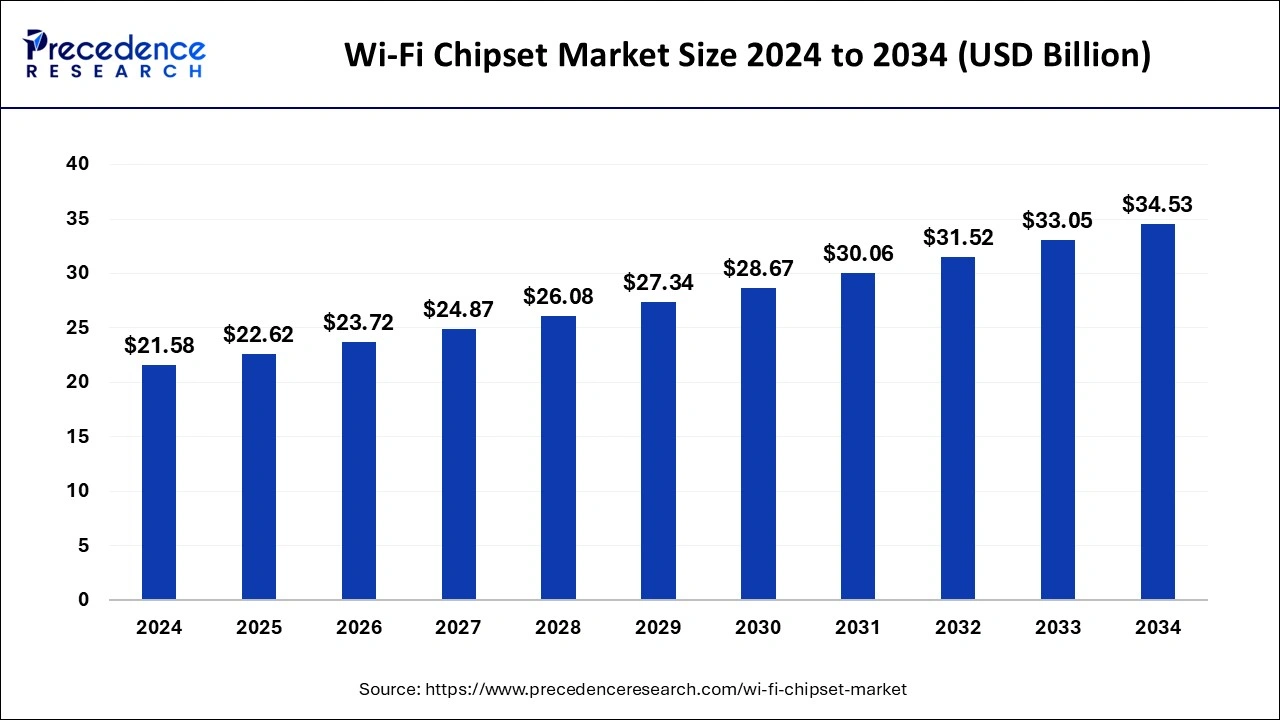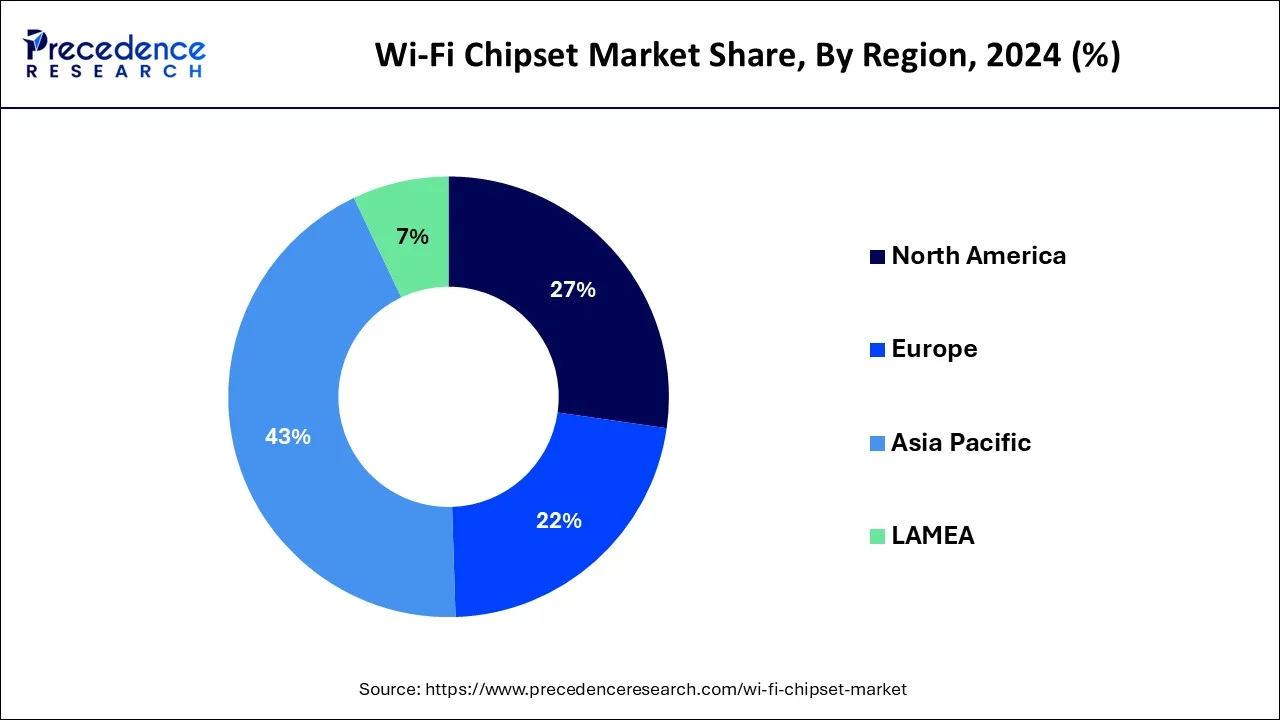Wi-Fi Chipset Market Size and Forecast 2025 to 2034
The global Wi-Fi chipset market size was estimated at USD 21.58 billion in 2024 and is predicted to increase from USD 22.62 billion in 2025 to approximately USD 34.53 billion by 2034, expanding at a CAGR of 4.81% from 2025 to 2034. The Wi-Fi chipset market is driven by an increase in the need for high bandwidth uses across the globe.

Wi-Fi Chipset Market Key Takeaways
- Asia-Pacific dominated the Wi-Fi chipset market with largest market share of 43% in 2024.
- By type, the dual band segment dominated the market in 2024.
- By end-use, the consumer devices segment dominated the Wi-Fi chipset market.
Asia PacificWi-Fi Chipset Market Size and Growth 2025 to 2034
The Asia Pacific Wi-Fi chipset market size reached USD 9.28 billion in 2024 and is expected to be worth around USD 15.02 billion by 2034 with a notable CAGR of 4.93% from 2025 to 2034.

Asia-Pacific carried the largest market share in 2024 in the Wi-Fi chipset market and is observed to carry the position throughout the predicted timeframe. Rapid industrialization and urbanization in the Asia-Pacific region have sparked the growth of smart cities, industrial automation, and Internet of Things applications. Strong connectivity solutions are required for these trends, and Wi-Fi is one of the most widely used wireless communication technologies. The need for Wi-Fi chipsets rises with the adoption of increasingly linked technology by industries and metropolitan regions. The region's governments frequently enact laws and provide incentives to encourage the uptake of digital technology and stimulate innovation in the IT sector.

An environment that is favorable to the expansion of the Wi-Fi chipset industry is created by tax breaks, supportive regulatory frameworks, and R&D investments. Many leading semiconductor and electronics companies are based in countries like China, Taiwan, South Korea, and Japan. These countries have well-established manufacturing facilities and supply chains, allowing them to produce Wi-Fi chipsets at scale and competitive prices. The Asia Pacific region has a large and rapidly growing consumer electronics market. With the increasing adoption of smartphones, tablets, laptops, smart home devices, and IoT devices, there is a high demand for Wi-Fi chipsets in this region.
North America is observed to show a significant growth in the Wi-Fi chipset market during the forecast period. Due to ongoing improvements in Wi-Fi technology, newer generations of Wi-Fi chipsets are being created to offer faster speeds, wider coverage, and increased energy economy. As early adopters of new technology, North American consumers are a significant factor in the demand for the newest Wi-Fi chipsets in laptops, smartphones, tablets, smart home appliances, and Internet of Things devices.
Although 5G technology mainly focuses on cellular connectivity, it also enhances Wi-Fi networks. Wi-Fi and 5G network integration are becoming more popular as 5G networks spread throughout North America and offer smooth connectivity experiences. This integration increases the need for Wi-Fi chipsets that can support these hybrid networks.
Market Overview
The Wi-Fi chipset market includes firms that design and produce integrated circuits for wireless communication in gadgets like laptops, routers, smartphones, and Internet of Things devices. Without the need for physical wires, these chipsets let devices connect to Wi-Fi networks, enabling data transfer and internet access. Wi-Fi chipsets must conform to industry standards to guarantee compatibility and interoperability with various devices and networks. Chipset manufacturers collaborate closely with standardization organizations such as the Institute of Electrical and Electronics Engineers (IEEE) to ensure that their products fulfill these standards and promote smooth communication between devices and networks.
Wi-Fi Chipset Market Growth Factors
- The need for high-bandwidth internet is growing, which boosts the demand for Wi-Fi chipsets while promoting the overall growth of the market.
- Expansion of AR/VR and smart home applications is observed to help the Wi-Fi chipset market to grow in the upcoming years.
- Creation of the upcoming smartphone generation is also observed to promote the market's expansion.
Market Scope
| Report Coverage | Details |
| Growth Rate from 2025 to 2034 | CAGR of 4.81% |
| Market Size in 2025 | USD 22.62 Billion |
| Market Size by 2034 | USD 34.53 Billion |
| Largest Market | Asia Pacific |
| Base Year | 2024 |
| Forecast Period | 2025 to 2034 |
| Segments Covered | By Type, and By Application |
| Regions Covered | North America, Europe, Asia-Pacific, Latin America, and Middle East & Africa |
Market Dynamics
Drivers
Increasing demand for wireless connectivity
The demand for ubiquitous wireless connectivity has increased due to the exponential growth in smart gadgets, including tablets, smartphones, smartwatches, and Internet of Things devices which promotes the expansion of the Wi-Fi chipset market. Manufacturers must incorporate Wi-Fi chipsets into their products because consumers demand seamless connectivity regardless of location or device. Innovation in wireless connectivity is fueled by the integration of 5G technology with Wi-Fi chipsets. Wi-Fi and 5G hybrid networks provide improved coverage, capacity, and speed to meet the increasing demand for high-bandwidth applications like streaming ultra-high-definition video and augmented reality.
Growing need for Wi-Fi chipsets
The need for Wi-Fi chipsets has increased due to the growing use of smartphones, tablets, laptops, and other mobile devices, which is observed to act as a driver for the Wi-Fi chipset market. Customers anticipate smooth, quick Wi-Fi connections everywhere, including public areas, offices, and residences. Manufacturers are compelled by consumer demand to incorporate cutting-edge Wi-Fi chipsets into their gadgets to provide high-performance wireless connectivity. There's a rising trend toward combining 5G and Wi-Fi technology to provide better connectivity experiences as 5G networks expand globally. Chipsets for Wi-Fi that can operate harmoniously with 5G networks, offloading data traffic and offering complementary coverage, are well-positioned to benefit from this development.
Restraint
Wi-Fi signals have limited range, especially at higher frequencies
Wi-Fi runs in the radio frequency (RF) spectrum, usually in the 2.4 and 5 GHz bands, which is essential to understand. Because these frequencies can partially pass through walls and other obstructions, they are perfect for wireless communication. Higher frequencies, such as those in the 5 GHz range, are constrained by their shorter wavelengths than lower frequencies. Higher frequencies make Wi-Fi signals more prone to attenuation, which means they weaken more quickly as they pass through objects like walls, furniture, and the air. This phenomenon results from these barriers' increased ability to absorb and scatter higher frequency signals, shortening the Wi-Fi signal's effective range.
Opportunities
Proliferation of IoT devices across various industries
A growing trend in edge computing, where data processing and analysis take place closer to the source of data collection, is driven by the proliferation of IoT devices. Due to Wi-Fi chipsets with sophisticated processing capabilities, edge devices can perform real-time analytics, extract actionable information, and react quickly to critical events without depending entirely on cloud infrastructure. This shift towards edge computing further heightened the need for strong and effective Wi-Fi chipsets that can enable edge intelligence in Internet of Things deployments.
Adopting Wi-Fi for their networking needs
The number of connected devices keeps rising due to the growth of smart gadgets and the Internet of Things. These devices, from laptops and smartphones to industrial gear and smart home appliances, need dependable communication. Because of its adaptability, interoperability, and speed, Wi-Fi has become the standard option for connecting various devices. Regarding networking, Wi-Fi is more affordable and scalable than conventional options like Ethernet. Implementing Wi-Fi networks allows expensive cabling infrastructure to be avoided, making growth and flexibility easier. Wi-Fi is a desirable alternative for all organizations, from startups to major corporations.
Type Insights
The dual band segment dominated the Wi-Fi chipset market in 2024. Dual-band Wi-Fi chipsets function in the frequency ranges of 2.4 and 5 GHz. Due to their versatility, they can adjust to different networking conditions. The 2.4 GHz band provides greater coverage and wall penetration, making it appropriate for older devices and larger areas. Meanwhile, 5 GHz bands offer reduced interference and higher speeds, making them perfect for densely populated urban areas and applications requiring a lot of bandwidth. Reliability and user experience are improved when these bands may be seamlessly switched between depending on network conditions.
The tri-band segment shows a significant growth in the Wi-Fi chipset market during the forecast period. The demand for faster and more dependable internet access is rising due to the increasing use of virtual reality apps, high-definition multimedia content, online gaming, and Internet of Things devices. Compared to their dual-band predecessors, tri-band Wi-Fi chipsets provide faster data transfer rates and lower latency, which makes them perfect for applications requiring a lot of bandwidth. Strong residential Wi-Fi networks are becoming increasingly in demand due to the COVID-19 epidemic and the increased use of online learning and distant work. Tri-band chipsets improve performance in crowded wireless areas, guaranteeing students, remote workers, and other users who depend on internet connectivity for daily tasks a smooth online experience.
Application Insights
The consumer devices segment dominated the Wi-Fi chipset market in 2024. The global demand for Wi-Fi-enabled devices has increased exponentially with the widespread use of smartphones and tablets. Wi-Fi chipsets play a significant role in enabling wireless connectivity in these consumer electronics, which propels the expansion of the consumer devices market. In recent years, gaming consoles and streaming gadgets have grown in popularity. Wi-Fi connectivity is necessary for these devices, including streaming devices like Roku and Amazon Fire Stick and game consoles like PlayStation and Xbox, to access online gaming services, streaming platforms, and content libraries. The need for Wi-Fi chipsets in these devices and the gaming and entertainment sectors are rising.
On the other hand, the smart home devices segment is observed to witness a rapid expansion during the forecast period in the Wi-Fi chipset market. The rising popularity of smart home settings, along with the integration of artificial intelligence for the same is observed to promote the segment's expansion. Wi-Fi infrastructure is already prevalent in many homes and public spaces worldwide. This ubiquity makes it easy for consumers to integrate new Wi-Fi-enabled smart home devices into their existing networks without the need for additional infrastructure investments.
Wi-Fi Chipset Market Companies
- ASUSTeK Computer Inc
- GCT Semiconductor Inc.
- Huawei Technologies Co. Ltd.
- Infineon Technologies AG
- Intel Corp.
- Realtek Semiconductor Corp.
- Samsung Electronics Co. Ltd.
- Skyworks Solutions Inc.
- Sony Group Corp.
- Texas Instruments Inc.
- Marvell Technology Inc.
- MediaTek Inc.
- Microchip Technology Inc.
- NXP Semiconductors NV
- ON Semiconductor Corp.
- PERASO INC.
- Qualcomm Inc.
Recent Developments
- In January 2024, after introducing multiple chips and devices that enabled Wi-Fi 7, the Wi-Fi Alliance formally introduced the Wi-Fi CERTIFIED 7 program, authorizing end-user devices like smartphones. As a result, devices that are "Wi-Fi 7 ready" will now be able to formally support the new standard.
- In October 2022, Aglobal, a global pioneer in IoT platforms and cloud computing solutions, and MediaTek, a chip manufacturer, established a strategic partnership to launch 5G and Wi-Fi router solutions.
Segments Covered in the Report
By Type
- Dual band
- Tri-band
- Single band
By Application
- Consumer devices
- Smart home devices
- Gaming devices
- Drones
- Others
By Geography
- North America
- Asia Pacific
- Europe
- Latin America
For inquiries regarding discounts, bulk purchases, or customization requests, please contact us at sales@precedenceresearch.com
Frequently Asked Questions
Ask For Sample
No cookie-cutter, only authentic analysis – take the 1st step to become a Precedence Research client
 sales@precedenceresearch.com
sales@precedenceresearch.com
 +1 804-441-9344
+1 804-441-9344